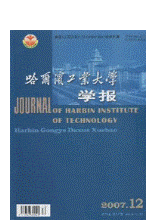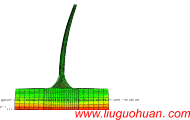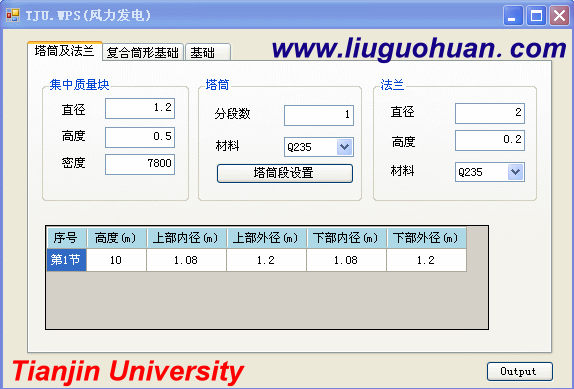A new analytical method for stochastic response of structure-damper system作者: Guo Wei, Li Hongnan, Liu-Guohuan |
||||||
下载次数:
次 更多论文下载...
PDF格式(左键浏览,右键另存):
Abstract:Fundamental principles from structural dynamics, pseudo excitation method and perturbation techniques are used to develop a new fast stochastic method for seismic analysis of the combined structuredamper system. In the approach, the mathematical equation of structure-damper system is expressed in the perturbation form, based on which the inverse operation of the matrices is avoided. Moreover, the new method also does not need the solution of any complex eigenvalue problem, in contrast to other methods found in the literature. Finally, the computation efficiency of the method is examined, and numerical comparisons with exact results are carried out to verify the accuracy of the proposed method. In all cases examined, the approach presented here shows excellent agreement with the exact results. Keywords:structure-damper system, non-proportional damping, perturbation techniques, stochastic analysis,pseudo excitation method. Introduction The adoption of supplemental damping elements in civil structures has been introduced in the relatively recent past as an innovative technology for reducing the level of vibration, which is usually related to wind and earthquake actions. Because of the nonproportional damping characteristic of the combined structure-damper system, the decoupled seismic analysis can not be performed by the undamped realvalued modal matrix. Alternatively, the structuredamper system can be analyzed directly by considering the combined system as a single dynamic unit,by determining the complex eigenproperties of the combined system via state-space approach firstly proposed by Foss (1958), and then by employing a modal analysis. However, the calculation of complex eigenvalues problem is cumbersome and timeconsuming,and thus attempts to overcome the computational difficulties of the approach have been carried out by Lou et al. (2003), Karen et al. (2005),Fernando et al. (2006). Besides, it may sometimes be necessary to consider a number of design alternatives of the damping system and then, such an analysis would involve the evaluation of the dynamic properties of the combined structure-damper system several times. In order to avoid a great deal of repeated calculation of the complex eigenvalue problems,several measures have been studied. Based on the pseudo force method studied by Claret et al.(1991), Lin et al. (2003), an iterative procedure for computing the transfer function matrix of a nonclassically damped system has been developed by Jandid et al. (1993), Zavoni et al. (2006). The iterative methods have more advantages than the complex modal superposition methods in terms of speed,and it retains the advantages of the real-valued modal superposition methods. This paper presents a new stochastic method for the seismic analysis of combined structure-damper system. The pseudo excitation method proposed by Lin (1992) is introduced for its high computation efficiency. Besides, based on the perturbation techniques, the inverse operation of matrices in the pseudo excitation method for non-proportionally damped system is avoided. Meanwhile, the stochastic response analysis of the combined structuredamper system is free of the determination of complex eigenvalues and eigenvectors, and the matrix of power spectral density (PSD) function is expressed in a matrix sequence form. In the end, numerical comparisons with exact results are carried out to examine the accuracy of the proposed method. The results prove the accuracy of the new approach. Conclusions A new stochastic method for seismic analysis of structure-damper system has been presented. The accuracy and validity of the proposed approach are proven both mathematically and numerically and the results show excellent agreement with the exact results. In contrast to other methods found in the literature, the two main advantages of the new method are: 1: The determination of complex eigenvalues and eigenvetors of non-proportionally damped system is avoided, by which the computation efficiency can be dramatically improved, especially for the structuredamper system which requires repeated calculation of eigenvalue problems. 2: The inverse operation of the matrices, which may lead to computation difficulties for ill conditioned matrices, is avoided based on the perturbation techniques. Meanwhile, no additional computation cost is introduced. The new method is efficient and accurate for stochastic analysis of seismic response of structure-damper system. References: [1] Foss, K.A., “Coordinates which Uncouple the Equation of Motion of Damped Linear Dynamic Systems”, Journal of Applied Mechanics-ASME, Vol. 25, No. 1, 1958, pp 361- 364. [2] Lou, M.L., Duan, Q., Chen, G.D., “Modal Perturbation Method and its Applications in Structural Systems”, Journal of Engineering Mechanics-ASCE, Vol. 169, No. 8, 2003, pp 935-943. [3] Karen, K., Mohsen, G. A., “New Approaches for Non-Classically Damped System Eigenanalysis”, Earthquake Engineering and Structural Dynamics, Vol. 34, No. 9, 2005, pp 1073–1087. [4] Fernando, C., María, J.E., “Computational Methods for Complex Eigenproblems in Finite Element Analysis of Structural Systems with Viscoelastic Damping Treatments”, Computer Methods in Applied Mechanics and Engineering,Vol. 195, No. 44-47, 2006, pp 6448-6462. [5] Claret, A.M., Venancio-Filho, F., “A Modal Superposition Pseudo-Force Method for Dynamic Analysis of Structural Systems with Non-Proportional Damping”, Earthquake Engineering and Structural Dynamics, Vol. 20, No. 4, 1991,pp 303-315. [6] Lin, F.B., Wang, Y.K., Cho, Y.S., “A Pseudo-Force Iterative Method with Separate Scale Factors for Dynamic Analysis of Structures with Non-Proportional Damping”,Earthquake Engineering and Structural Dynamics, Vol. 32, No. 2, 2003, pp 329–337. [7] Jandid, R.S., Datta, T.K., “Spectral Analysis of Systems with Non-Classical Damping Using Classical Mode Superposition Technique”, Earthquake Engineering and Structural Dynamics, Vol. 22, No. 8, 1993, pp 723-735. [8] Zavoni, E.H., Pérez, A.P., Cicilia, F.B., “A Method for the Transfer Function Matrix of Combined Primary-Secondary Systems Using Classical Modal Decomposition”, Earthquake Engineering and Structural Dynamics, Vol. 35, No. 2,2006, pp 251-266. [9] Lin, J.H., “A Fast CQC Algorithm of PSD Matrices for Random Seismic Responses”, Computers and Structures, Vol. 44, No. 3, 1992, pp 683-687. [10] Xu, Y.L., Zhang, W.S., “Modal Analysis and Seismic Response of Steel Frames with Connection Dampers”, Engineering Structures, Vol. 23, No. 4, 2001, pp 385-396. [11] Wang, M.F., “Pseudo-excitation Method for Stationary Random Responses of Non-Proportionally Damped MDOF Systems”, Chinese Journal of Computational Mechanics, Vol. 25, No. 1, 2008, pp 94-99. (in Chinese) [12] Lin, J.H., Zhang, Y.H., 2004, Pseudo-Excitation Method of Random Vibration, Beijing: Science Press. (in Chinese) |
||||||
| welcome to www.liuguohuan.net |
| 天津大学 建筑工程学院 ; 天津大学 前沿技术研究院; 国家重点实验室-水利工程仿真与安全 |







